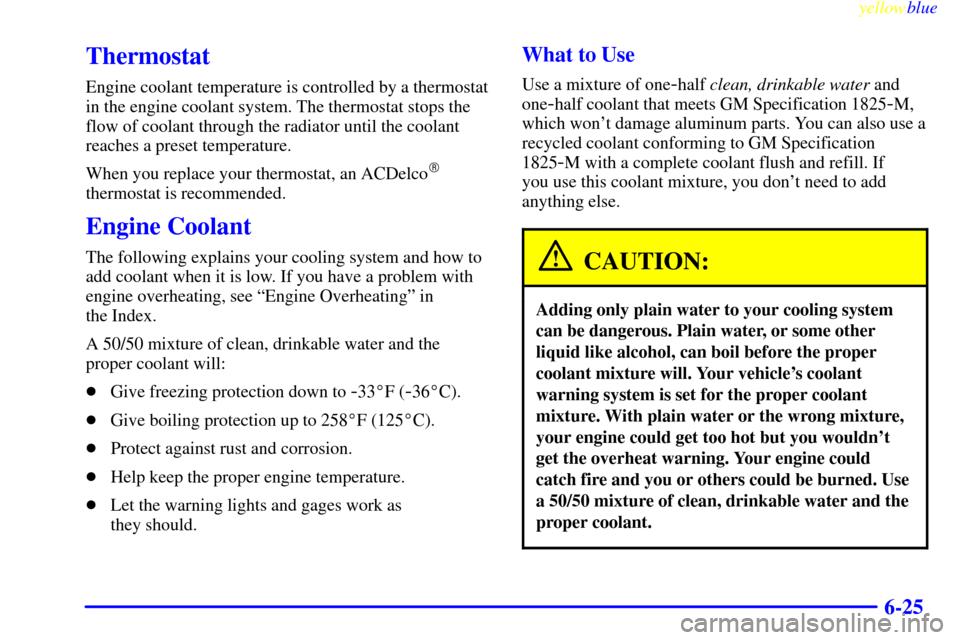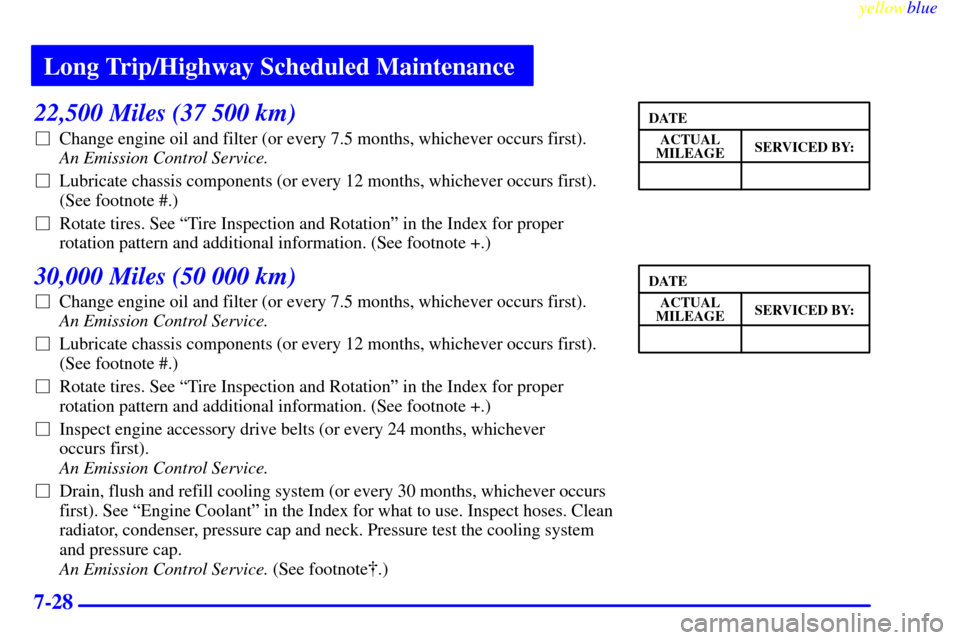Page 217 of 328

yellowblue
6-25
Thermostat
Engine coolant temperature is controlled by a thermostat
in the engine coolant system. The thermostat stops the
flow of coolant through the radiator until the coolant
reaches a preset temperature.
When you replace your thermostat, an ACDelco
�
thermostat is recommended.
Engine Coolant
The following explains your cooling system and how to
add coolant when it is low. If you have a problem with
engine overheating, see ªEngine Overheatingº in
the Index.
A 50/50 mixture of clean, drinkable water and the
proper coolant will:
�Give freezing protection down to
-33�F (-36�C).
�Give boiling protection up to 258�F (125�C).
�Protect against rust and corrosion.
�Help keep the proper engine temperature.
�Let the warning lights and gages work as
they should.
What to Use
Use a mixture of one-half clean, drinkable water and
one
-half coolant that meets GM Specification 1825-M,
which won't damage aluminum parts. You can also use a
recycled coolant conforming to GM Specification
1825
-M with a complete coolant flush and refill. If
you use this coolant mixture, you don't need to add
anything else.
CAUTION:
Adding only plain water to your cooling system
can be dangerous. Plain water, or some other
liquid like alcohol, can boil before the proper
coolant mixture will. Your vehicle's coolant
warning system is set for the proper coolant
mixture. With plain water or the wrong mixture,
your engine could get too hot but you wouldn't
get the overheat warning. Your engine could
catch fire and you or others could be burned. Use
a 50/50 mixture of clean, drinkable water and the
proper coolant.
Page 218 of 328
yellowblue
6-26
NOTICE:
If you use an improper coolant mixture, your
engine could overheat and be badly damaged.
The repair cost wouldn't be covered by your
warranty. Too much water in the mixture can
freeze and crack the engine, radiator, heater core
and other parts.
If you have to add coolant more than four times a year,
have your dealer check your cooling system.
NOTICE:
If you use the proper coolant, you don't have to
add extra inhibitors or additives which claim to
improve the system. These can be harmful.
Checking Coolant
The vehicle must be on a level surface. When your
engine is cold, the coolant level should be at LOW, or a
little higher. When your engine is warm, the level should
be up to FULL, or a little higher.
Page 219 of 328
yellowblue
6-27
Adding Coolant
If you need more coolant, add the proper coolant
mixture at the coolant recovery tank, but be careful not
to spill it.
CAUTION:
Turning the radiator pressure cap when the engine
and radiator are hot can allow steam and scalding
liquids to blow out and burn you badly. With the
coolant recovery tank, you will almost never have
to add coolant at the radiator. Never turn the
radiator pressure cap
-- even a little -- when the
engine and radiator are hot.
CAUTION:
You can be burned if you spill coolant on hot
engine parts. Coolant contains ethylene glycol,
and it will burn if the engine parts are hot
enough. Don't spill coolant on a hot engine.
Power Steering Fluid
When to Check Power Steering Fluid
It is not necessary to regularly check power steering
fluid unless you suspect there is a leak in the system or
you hear an unusual noise. A fluid loss in this system
could indicate a problem. Have the system inspected
and repaired.
Page 221 of 328
yellowblue
6-29
Open the cap with the washer symbol on it. Add washer
fluid until the tank is full.
NOTICE:
�When using concentrated washer fluid,
follow the manufacturer's instructions for
adding water.
�Don't mix water with ready
-to-use washer
fluid. Water can cause the solution to freeze
and damage your washer fluid tank and
other parts of the washer system. Also,
water doesn't clean as well as washer fluid.
�Fill your washer fluid tank only
three
-quarters full when it's very cold. This
allows for expansion if freezing occurs,
which could damage the tank if it is
completely full.
�Don't use engine coolant (antifreeze) in
your windshield washer. It can damage
your washer system and paint.
Brakes
Brake Fluid
Your brake master cylinder reservoir is on the driver's
side of the engine compartment. It is filled with DOT
-3
brake fluid.
Page 268 of 328

Short Trip/City Scheduled Maintenance
yellowblue
7-12
27,000 Miles (45 000 km)
�Change engine oil and filter (or every 3 months, whichever occurs first).
An Emission Control Service.
30,000 Miles (50 000 km)
�Change engine oil and filter (or every 3 months, whichever occurs first).
An Emission Control Service.
�Lubricate chassis components (or every 6 months, whichever occurs first).
(See footnote #.)
�Inspect engine accessory drive belts (or every 24 months, whichever
occurs first).
An Emission Control Service.
�Drain, flush and refill cooling system (or every 30 months, whichever occurs
first). See ªEngine Coolantº in the Index for what to use. Inspect hoses. Clean
radiator, condenser, pressure cap and neck. Pressure test the cooling system
and pressure cap.
An Emission Control Service. (See footnote�.)
�Replace spark plugs.
An Emission Control Service.
�Inspect ignition coil plug cap (1.3L Code 2 L4 engine only) (or every
30 months, whichever occurs first).
An Emission Control Service. (See footnote�.)
ACTUAL
SERVICED BY:MILEAGE
DATE
ACTUAL
SERVICED BY:MILEAGE
DATE
Page 273 of 328
Short Trip/City Scheduled Maintenance
yellowblue
7-17
57,000 Miles (95 000 km)
�Change engine oil and filter (or every 3 months, whichever occurs first).
An Emission Control Service.
60,000 Miles (100 000 km)
�Change engine oil and filter (or every 3 months, whichever occurs first).
An Emission Control Service.
�Lubricate chassis components (or every 6 months, whichever occurs first).
(See footnote #.)
�Inspect engine accessory drive belts (or every 24 months, whichever
occurs first).
An Emission Control Service.
�Inspect camshaft timing belt.
An Emission Control Service. (See footnote�.)
�Drain, flush and refill cooling system (or every 30 months, whichever occurs
first). See ªEngine Coolantº in the Index for what to use. Inspect hoses. Clean
radiator, condenser, pressure cap and neck. Pressure test the cooling system
and pressure cap.
An Emission Control Service. (See footnote�.)
(Continued)
ACTUAL
SERVICED BY:MILEAGE
DATE
ACTUAL
SERVICED BY:MILEAGE
DATE
Page 278 of 328

Short Trip/City Scheduled Maintenance
yellowblue
7-22
87,000 Miles (145 000 km)
�Change engine oil and filter (or every 3 months, whichever occurs first).
An Emission Control Service.
90,000 Miles (150 000 km)
�Change engine oil and filter (or every 3 months, whichever occurs first).
An Emission Control Service.
�Lubricate chassis components (or every 6 months, whichever occurs first).
(See footnote #.)
�Inspect engine accessory drive belts (or every 24 months, whichever
occurs first).
An Emission Control Service.
�Drain, flush and refill cooling system (or every 30 months, whichever occurs
first). See ªEngine Coolantº in the Index for what to use. Inspect hoses. Clean
radiator, condenser, pressure cap and neck. Pressure test the cooling system
and pressure cap.
An Emission Control Service. (See footnote�.)
�Replace spark plugs.
An Emission Control Service.
�Inspect ignition coil plug cap (1.3L Code 2 L4 engine only) (or every
30 months, whichever occurs first).
An Emission Control Service.
ACTUAL
SERVICED BY:MILEAGE
DATE
ACTUAL
SERVICED BY:MILEAGE
DATE
Page 284 of 328

Long Trip/Highway Scheduled Maintenance
yellowblue
7-28
22,500 Miles (37 500 km)
�Change engine oil and filter (or every 7.5 months, whichever occurs first).
An Emission Control Service.
�Lubricate chassis components (or every 12 months, whichever occurs first).
(See footnote #.)
�Rotate tires. See ªTire Inspection and Rotationº in the Index for proper
rotation pattern and additional information. (See footnote +.)
30,000 Miles (50 000 km)
�Change engine oil and filter (or every 7.5 months, whichever occurs first).
An Emission Control Service.
�Lubricate chassis components (or every 12 months, whichever occurs first).
(See footnote #.)
�Rotate tires. See ªTire Inspection and Rotationº in the Index for proper
rotation pattern and additional information. (See footnote +.)
�Inspect engine accessory drive belts (or every 24 months, whichever
occurs first).
An Emission Control Service.
�Drain, flush and refill cooling system (or every 30 months, whichever occurs
first). See ªEngine Coolantº in the Index for what to use. Inspect hoses. Clean
radiator, condenser, pressure cap and neck. Pressure test the cooling system
and pressure cap.
An Emission Control Service. (See footnote�.)
ACTUAL
SERVICED BY:MILEAGE
DATE
ACTUAL
SERVICED BY:MILEAGE
DATE